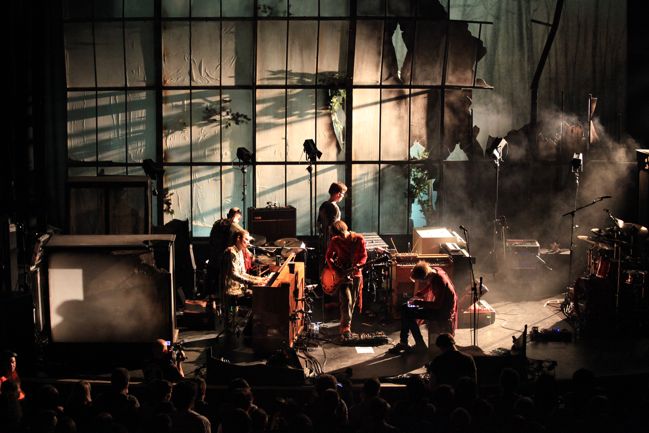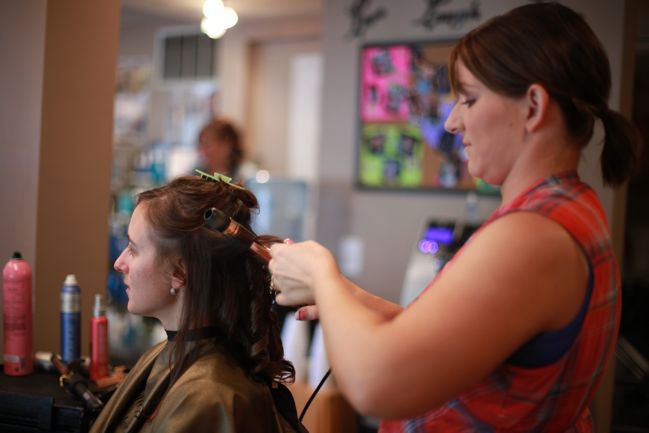Camera School 02 :: Let ISO set you free

I promised I wouldn’t make this technical. I promise to keep that promise. And that’s because my entire process for taking a picture is about stripping away as much of the technical as I can. Basically if you can totally figure out just a couple basics, then the rest gets really easy.
You know what else I promise? No triangles. Hear me out.
Exposure is a fancy photography word that refers to how much light is in the picture – is it too light, too dark or just right? And if you read articles or indeed whole books on exposure, they will inevitably start talking about this triangle where you have to balance three different things on every single shot to get the exposure right. And okay, if you break it down that is entirely true, but the triangle thing just does not work for me. Because it makes it seem like you have to come up with this perfect combination of three different things every single time we click the shutter. Who has time to think about all that stuff on every shot? (Okay, superhero photographers totally do. I am not a superhero photographer and I’m cool with that. Way less pressure to save the world.)
So I would rather think about just one technical thing on each shot. I think that’s an amount of technical stuff I can handle on a shot-by-shot basis. I’d rather get the other stuff sorted and out of the way so I can minimise what I have to consider for each click. I start with the easiest of the three things: ISO.
 Trinity College, Dublin, on a sunny day – shot at 200 ISO. SOOC.
Trinity College, Dublin, on a sunny day – shot at 200 ISO. SOOC.
Now don’t even go into worrying about what ISO stands for. There will be no quiz. The IS in ISO has to do with the novel idea that there should be an international standard. Back in the seventies, the various film companies thought it would be helpful if a 100 film was always pretty much the same thing and a 400 was always the same and an 800 was the same, and so on. No matter what brand of film you bought. I love that they did this. So when you had a film camera, you had to look at the conditions, choose the film speed that would be best for those conditions and then you were stuck with that ISO until you got to the end of the roll of film. In general, 100 film was great for bright sunshine, 400 was a happy medium for overcast days or shooting indoors and 800 or higher was what you needed to shoot in low light. I’m simplifying, but this is the overall outline. Three points to remember: 100, 400, 800. There were plenty of other speeds, but those three would get you through the vast majority of all your needs.
But that was film. Now we have digital equivalents and they kept the term ISO except THEY DIDN’T FOLLOW ANY STANDARD. Oh nice one, camera companies. Really. So my 100 may not be your 100 and that’s not super helpful. But the 100, 400, 800 rule is still your best bet. They didn’t follow the standard closely but they did stay in line with the general concept. So if it’s sunny, you can set your camera to 100, if you’re indoors or it’s overcast outside, try 400 and if it’s pretty dark, try 800. Now you might have other options to go much higher than 800 now – it just depends on your camera. And because digital cameras don’t follow a single standard, you may want to try out other numbers around 100, 400 and 800 to see if your camera just likes another number better. But if you can remember those three numbers, you can set the ISO once for your conditions and then stop thinking about it entirely until those conditions change.
I really like it when I can just set something, leave it and not have to think about it.
It can also completely ruin everything. Let me illustrate.
 Not the 2006 pictures, but another concert with low light. This is at ISO 5000. Really. SOOC, but this lost a lot of detail in shrinking it for the blog.
Not the 2006 pictures, but another concert with low light. This is at ISO 5000. Really. SOOC, but this lost a lot of detail in shrinking it for the blog.
In 2006, I shot some concert photos in a dark club with a few stage lights. So my ISO was set as high as I dared since there wasn’t much light at all (and flash and concerts do not mix). No problem – shot the pictures, came home, went to sleep.
Except the next morning we were going on holiday. To Iceland. In summer. WHEN THE SUN NEVER SETS, essentially. Do you see where this is going yet? I was taking pictures in bright sunshine at almost all hours of the day and my ISO was set somewhere around 1200 for four entire days. (You can see a sampling of those shots here.) I think I was just so excited about being there that I forgot how to work my camera.
If you shoot in bright sunlight at a high speed (like 800+) when you really only needed 100 or 200, your photos can still look fine on the view screen of your camera. But when you download them to your computer or print them, you’ll find they aren’t as clean as you would like. There’s lots of grit (often called ‘noise’) and the colours don’t come out as smooth as they should. If you try to zoom in or print those photos at a big size, they will be a bigger mess. It looks similar to when you take a really low quality digital image (like a quick snap from a phone or a really old digital camera) and blow it up – it’s not quite boxy pixels but it’s also not quite right either.
So while I love that I can remember those three numbers, set my ISO and not worry about it until the conditions change, I must worry about it when the conditions change. On the fifth day in Iceland I reverted to my normal habits, turned the camera on and immediately went to set the ISO, which was when I first noticed that giant mistake I had made. Time to set the ISO right and move forward. The photos from the second half of the Iceland trip are so much nicer than the first half. Smooth even. There are a few shots in there that I totally love to this day, and they were taken with my very first digital camera (the Canon 300) and today there are mobile phones with more detail to the images. Oh digital technology: you are so fickle and changing unlike the long life of a film camera!
If you learn from my non-ISO-changing stupidity, you can avoid your own batch of priceless-but-gritty photos and remember the key element here: set the ISO once for your conditions and then stop thinking about it entirely until those conditions change.
 Indoors with a mix of light sources, shot at 640. SOOC – though this is the kind of image that would benefit greatly from some additional processing.
Indoors with a mix of light sources, shot at 640. SOOC – though this is the kind of image that would benefit greatly from some additional processing.
Lesson two’s assignment has two options. Option A is for anyone who just read this and thought I don’t even know where the ISO is on my camera. It is totally time to learn. All cameras have different buttons and wheels so there are two places that can help you super quick: your camera manual (look up ISO in the index) or Google (type in ‘how to set the ISO on’ followed by the name of your specific camera). Seriously, seriously, seriously find how to change the ISO. It will set you free.
Option B is what you do once you know how to change the ISO. Take two clicks of the same scene – one with the correct ISO and one with it set way wrong, like a high ISO for a sunny day or a low ISO for darkness. You’ll probably need to do this in a mode other than fully automatic, since many completely automatic modes will set the ISO for you, but for the moment it really doesn’t matter which mode you pick. On an SLR, go for P (program mode) or A/Av (aperture-priority – Nikon and Canon use different notation). On a point and shoot the modes are a bit less standard from camera to camera, but for the sake of this exercise you can pick any mode that lets you set the ISO. Remember that 100-400-800 guideline and take two pictures that are identical except for the ISO. One shot with the right ISO and one with something to another extreme.
Transfer those pictures to your computer and have a look at them full screen. What happens on your camera if the ISO is too high? Too low? Sure, I could just tell you, but it works so much better to see it with your own eyes. Knowing how your camera behaves in different ISO settings will help you and your camera become buddies. I swear your camera will instantly have more respect for you.
And once you can control the ISO, the rest of this stuff is going to get way easier. Like what we’ll cover tomorrow in lesson three. So go take pictures of stuff!
A note about automatic ISO: I use it for one thing and one thing only. Video. I shoot my YouTube videos with the same camera I use for everything else, and almost entirely with natural light. But there is a problem that the darn clouds sometimes cover up the sun WHILE I AM RECORDING. So inconsiderate. It meant some of the video would be lighter and other parts darker. Setting the ISO to automatic means right in the middle of the video, the camera will compensate for the change in the light. That is awesome, and proves that my camera is willing to join me in the battle against the clouds. Or something. But the rest of the time, Camera and I are all about setting the ISO on a real number, not the auto setting. Added bonus of setting the ISO: longer battery life than on automatic.
![]() Read more about: camera-school photography
Read more about: camera-school photography
Next post: Camera School 03 :: Fix a photograph
Previous post: Scrapbooking Sketch of the Week






















